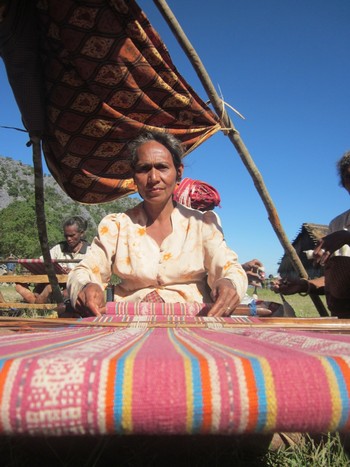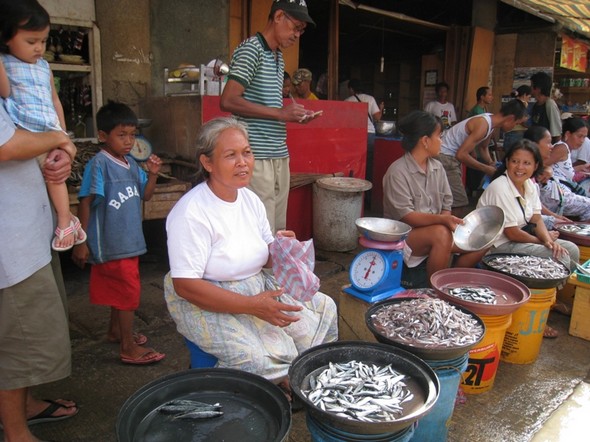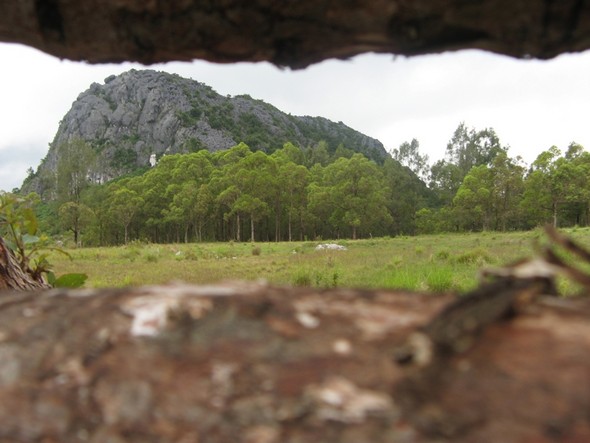Siti Maimunah
People hope to revive local traditions in TimorSiti Maimunah |
Marginalised communities across Indonesia have long faced threats of environmental destruction, and struggled against corporate resource exploitation and the state policies that support it. Now they also increasingly confront threats from climate change and the unpredictable extreme weather patterns it spawns. From farmers in remote parts of Timor to fishing communities in southern Sumatra, an increasingly erratic climate is affecting how millions of people make their livelihoods.
One way that local peoples have responded to these interlinked challenges is by calling for ‘climate justice’. Around Indonesia, local people are demanding policies that protect communities from impacts of both corporate greed and natural hazards, and that prioritise programs to cope with impacts of climate change.
The Molo and their environment
One place to start unravelling the threads that tie climate justice to broader issues of environmental injustice is in the foothills of Timor, in eastern Indonesia. Protests against quarrying and timber plantations in central south Timor also incorporate demands for climate justice. In late May 2011, over 3000 people from Tiga Batu Tungku gathered beneath Mt Naususu. They were celebrating the Ningkam Haumeni festival, named for the beeswax and sandalwood that symbolise wealth for Timorese. Through such festivals, the Molo, Amanuban and Amanatun peoples hope to reinvigorate traditions such as women’s weaving and men’s construction of ‘lopo’ round houses, and encourage young people to study and love nature and their ancestral culture. This was the second event marking local communities’ vow to protect ‘sovereignty without mining’ on their ancestral lands, and extend their commitment to resistance across Indonesia.
The Molo people’s vow to resist mining in their mountains has a philosophical basis. Quarrying Mt Maususu’s marble runs against Molo beliefs, which equate the earth to the human body. The Molo see rocks as the earth’s bones, soil as the earth’s flesh, water as its blood, and forest as the its skin, lungs, and hair. If rocks – the bones of a place – are shattered, this disrupts other functions too. Ten years ago, a marble quarry caused landslides that polluted water sources and aggravated social conflict. Uniting to save Mt Naususu, the Molo have prevented new quarrying and mining until now.
Farming and herding are the main livelihoods in some 47 Molo villages. But the area also leads central south Timor in rice production, and people there also grow maize and cassava. Yet Molo subsistence is threatened by extreme weather attributed in part to climate change, and a land grab by afforestation projects. Industrial timber plantations (HTI) threaten Molo herding livelihoods. Antonius Lasa, a Molo customary leader, explains that ‘afforestation is squeezing out pastures. Lowland water is polluted, and landslides are frequent in the surrounding uplands’.
Nor have water resources escaped undisturbed. Unpredictable rainfall now aggravates competition for Timor’s scarce water resources. Since 1999, the regional drinking water company has withdrawn 300 litres per second from the Koki River to supply So’e, central south Timor’s capital city, and a bottled water company. Previously, the Koki had irrigated rice fields and maize, chillies, cassava, and other vegetables in the villages of Tune and Bonle’u. With water diversion to So’e, some 500 hectares of rice fields and other croplands are unirrigated.
‘Cheating rain’ and women
With climate change, people in Timor, and throughout East Nusa Tenggara province, must also adapt to an increasingly unpredictable and extreme climate. The western monsoon buffets Timor with northwest winds and heavy rain. Then the eastern monsoon blows hot winds from the Australian desert, making Timor among the driest places in Indonesia. Recent weather extremes are unprecedented. ‘The normal rainy season, October to March, hasn’t happened’, explains Domingus Tse in Nusa village. Usually, he plants maize at the start of the normal rainy season. But with no rain, the corn is stunted, withers, and dies. Alternatively, if he waits to plant until the rains have started, the land is too wet. Farmers call this the ‘cheating rain’ (hujan tipu). Unpredictable rainfall not only harms crop growth, it also brings diseases like stem rot, insect pests including brown leaf hoppers, grasshoppers, and caterpillars, as well as mice and new species that farmers have not seen in the area before. The results are repeated crop failures.
 |
Mt. Naususu in West TimorSiti Maimunah |
The women suffer first from crop failures in Timor. Men traditionally lay priority claim to staple foods, despite women’s prominent roles in food production, from selecting seeds and designating planting areas to allocating grain and gathering food for their families. In Molo, women manage the ‘lopo’ (round house), which serves as both kitchen and harvest storage, signifying agricultural wealth. Molo mirrors Indonesia generally, where the Indonesian Farmers Union (Serikat Petani Indonesia) indicates that 70 to 80 per cent of workers in the agricultural sector are women.
The impacts of changing weather patterns extend far beyond East Nusa Tenggara’s farmers. Farmers throughout the archipelago, whose crops depend on rainfall alone, are masters of multi-cropping. ‘Tumpang sari’ is one generic Indonesian term for numerous farming and agroforestry systems where farmers plant many types of crops together on the same land, reducing their risk of crop failure. Farmers also dig ‘embung’, small rain storage tanks used to irrigate vegetables. In South Sulawesi, women farmers cover the soil with plastic to retain moisture in their gardens of cassava, sweet potatoes, and bananas.
Climate change also contributes to gendered migration patterns. To survive, many women move to work in Indonesia’s large cities and beyond, joining an international migrant labour stream. Several areas known as Indonesia’s ‘rice stores’ have recently become major origin points for migrant labour, including Java’s Indramayu, Cianjur, and Karawang, and Lombok’s Mataram. For example, three-quarters of the 90,000 workers that Indramayu sends abroad are women. Indonesian farmers, and especially rural women, can no longer depend on growing staple foods for a secure livelihood.
Fishing and tidal floods
Climate change is also a problem for coastal fishing communities. Unpredictable weather makes crucial fishing decisions difficult. If the wind blows from the east in the morning, fishers may be forced to return to port when heavy winds rise suddenly from the west. It has also become difficult to ‘read’ nature’s signs.
In the past, fishers in Krui, Lampung could predict the arrival of the western and eastern monsoons by reading the position of the ‘bintang pari’ southern constellation. The western monsoon began when pari’s head pointed up, or north. But that doesn’t work anymore. These past ten years, according to Krui fishers, the stars no longer provide the signs they need to predict the western monsoon. The star signs are still there, of course, but the weather does not match.
These past ten years Krui say the stars no longer provide the signs they need to predict the western monsoon
This situation makes fishing both difficult and dangerous for traditional fishermen who sail small boats, and can only catch fish in tranquil seas. Erratic weather makes it impossible for them to go to sea safely, drastically reducing their catch. According to a study of five fishing areas across Indonesia conducted by Kiara (People’s Coalition for Fisheries Justice) in 2010, fishers who previously put to sea 240 to 300 days per year can now only fish 160 to 180 days per year, reducing their income by 50 per cent to 70 per cent.
Women feel the pinch from this precipitous drop in household income, as well as from increasingly frequent tidal floods. Kiara’s research found that women who process shellfish on the north Jakarta coast work at least 17 hours per day. Their village along Angke Beach now floods at high tide, submerging houses as often as three times each month. A dam built three years ago has helped somewhat, reducing most floods to knee height.
For coastal households, surviving husbands’ reduced earnings means borrowing money, or selling, pawning, or mortgaging property. In Morodemak, Central Java, women are sent to seek these loans, making them vulnerable to unscrupulous lenders. Some fishing families have married off their underage daughters to shed responsibility for supporting them to new husbands, sacrificing these young women’s human rights.
Stories like these abound as flooding is expected to increase in cities in Java and some 750 islands in Indonesia. About 41.6 million Indonesians live in areas less than ten metres above sea level, likely to be vulnerable to flooding at high tide with rising sea levels. This reinforces the prediction that impacts of climate change will exacerbate poverty, especially among marginal small farmers and fishing communities.
Indonesia responds
The need for assistance to adapt to climate change is urgent. While reducing carbon emissions may mitigate climate change in the distant future, for many farmers and fishing communities today’s pressing problem is adapting to local impacts of climate change. Unfortunately, the government appears to be more concerned about tomorrow’s problem. Meanwhile, the immediate need to help people cope with climate change impacts is ignored, overshadowed by debates about Indonesia’s contribution to global warming, and the need to reduce carbon emissions from deforestation, forest fires, and peatland degradation.
In 2009 at the Copenhagen UN climate conference, President Yudhoyono declared Indonesia’s intention to reduce its carbon emissions 26 per cent by 2020. Indonesia has spent the past six years, since ratifying the UN Convention on Climate Change and the Kyoto Protocol, on developing mitigation policies that focus on emissions from forests and the use of forests to store carbon. There has been almost no action to assist marginalised people affected by climate change impacts.
The government appears to be more concerned about tomorrow’s problem. There has been almost no action to assist marginalised people affected by climate change impacts.
The long term solution is to plant trees. Bureaucrats around the country are reciting the slogan ‘One man, One tree’ while touting the government’s program to plant a billion trees. Yet the destruction of natural forests accelerates. In Riau, only 14,000 hectares of degraded and logged over natural forest were rehabilitated in 2004, while the Forestry Department issued permits for commercial industrial timber plantations (HTI) on nearly 52,000 hectares, an area nearly four times as large.
 |
Women fish processors face climate change impacts including tough working conditions and worsening tidal floodsKIARA (Peoples Coalition for Fisheries Justice) |
The government also prioritises REDD (Reducing Emissions from Deforestation and forest Degradation) above the rights and livelihoods of communities. Over 30 REDD pilot projects have spread across Indonesia since March 2010. Though they are still in trial stages, people living around REDD pilot projects are already feeling their negative impacts, including those in Jambi and Central Kalimantan. In November 2010, security personnel from PT Restorasi Ekosistem Indonesia (REKI), a company that is developing a REDD pilot project in Jambi, detained four people from a hamlet in Bungku, Batanghari. One of them, 32-year-old Mohamad Yusuf bin Somad, was seriously beaten. PT REKI’s ‘restoration’ projects extend over some 100,000 hectares of forests degraded by past logging operations. In the same area, farmers from the village of Penerokan insist that PT REKI is destroying their gardens, spawning conflict in the name of REDD. There are similar stories from other parts of Indonesia.
Climate program loans
Indonesia’s government has also sought funds to address climate change impacts through a loan scheme. From 2008 to 2010, Indonesia borrowed money for climate change impact programs from Japan, France, and the World Bank amounting so $US 1.9 billion. Presenting details of these loans to parliament after the fact, rather than debating them first in a representative forum, the money was apparently used to cover a national budget deficit, rather than for climate-specific programs.
Indonesian policies have been two-faced about climate mitigation. On the one hand, it claims to be playing a leading role in the global effort to reduce climate change. On the other hand, the government grants permits to exploit natural resources, licenses to destroy forests and for projects that raise carbon emissions. Despite the recent moratorium on new concessions, existing logging, oil palm, and mining concessions will continue to destroy or degrade hundreds of thousands of hectares of forest per year. In East Kalimantan alone, 303 large scale oil palm plantation concessions covered 3.65 million hectares in 2009. Last year, 1212 coal mining permits covered 4.4 million hectares.
According to Agus Purnomo, director of the National Climate Change Agency, the biggest problem is to prepare all sectors to work together. But farmers, fishers, and coastal aquaculturists (prawn farmers) cannot wait for the government. They are leading adaptation efforts. Many have begun to pursue their own strategies to address impacts of climate change. In Indramayu, farmers are beginning to plant drought-tolerant crops, and to experiment with crops on saline soils. Indramayu farmers, who traditionally focus on irrigated rice, are beginning to plant on dry land, using techniques that dramatically reduce the need for irrigation.
Global responsibility
Unfortunately, Indonesia’s government is not alone in neglecting the fate of fishing and farming populations in the face of climate change. These marginalised communities have fared little better in international climate change negotiations. With industrialised countries having made minimal efforts to reduce their own emissions, and now reneging on their commitments to help developing nations do the same, principles of climate justice are left far behind. To address climate change properly, we also need to make critical assessments of human security, ecological debt, land rights, and inequitable patterns of production and consumption. The main result of the Cancun climate meetings has emphasised carbon offsets. By the next round of UN climate change negotiations in Durban at the end of this year, developing nations will be responsible for up to 65 per cent of reductions in potential emissions.
We must urgently strive to reverse this potential catastrophe. Indonesia and other developing nations must act together to address climate change impacts. We must not be entrapped by industrialised countries’ tactics to shirk their obligations to reduce overconsumption of fossil fuels and profligate lifestyles by placing a monetary value on forests and biodiversity and then paying for use of our natural heritage. If we fall into that trap, it could well lead to a climate crisis that strangles both human life and earth’s future.
Siti Maimunah (mai.jebing@gmail.com) is the national coordinator of the Civil Society Forum for Climate Justice and is also active in the Mining Advocacy Network (Jaringan Advokasi Tambang, JATAM).
